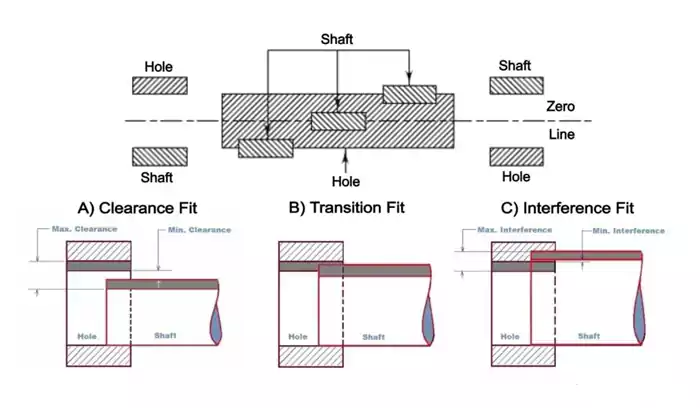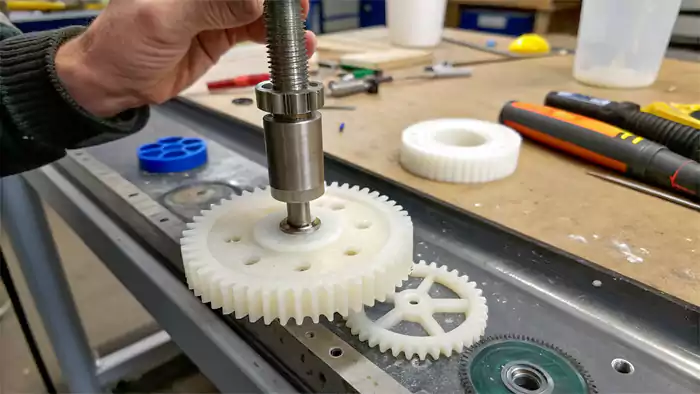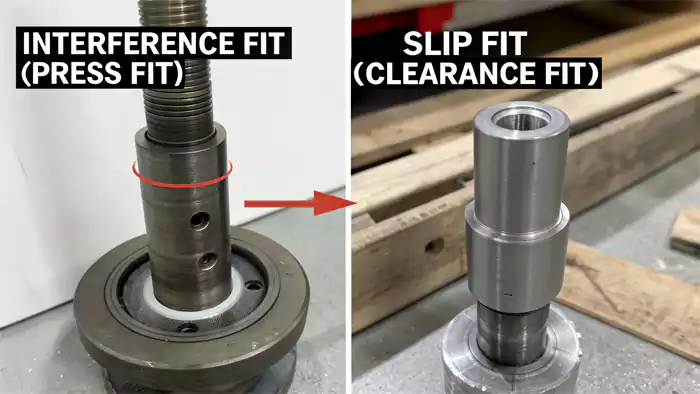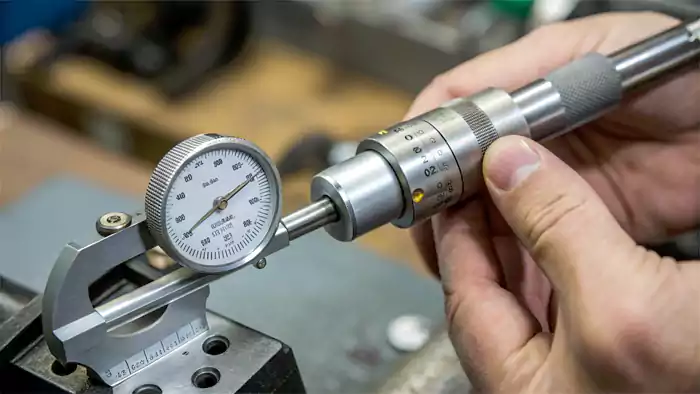What is press fit interference, and how can it make or break your assemblies?
Are your components failing to hold together securely, or worse, cracking under pressure during assembly? The secret might lie in getting your press fit interference just right.
Press fit interference is the intentional diametrical difference where an external part, like a shaft, is designed to be slightly larger than the internal part, like a hole, it fits into. This creates a tight, friction-based joint after the parts are forced together.
When I first got into CNC machining, particularly when designing parts that needed to hold together without extra screws or glue, understanding press fit interference was a game-changer.
It’s all about that precise amount of "squeeze." It’s a delicate balancing act. Too little interference, and things might loosen or slip under load. Too much, and you risk damaging the components, especially if you’re working with materials like plastics which are less forgiving than metals. For an engineer like David, who needs reliable assemblies for industrial automation, mastering press fit interference isn’t just important—it’s essential.
Let’s dive into what it is, how to get it right, and why it’s so crucial for strong, dependable connections.
What exactly defines the interference of a press fit?
Struggling to get a consistent grip between your mated parts? Precisely defining the interference is your first step towards a reliable fit.
The interference of a press fit is the specific dimensional overlap: it’s the amount by which the diameter of the male component (like a shaft) exceeds the diameter of the female component (like a hole) before they are assembled.

This isn’t just about making one part “a bit bigger” than the other—it’s about a calculated, precise value known as press fit interference. I learned early on that “eyeballing it” or going for “as tight as possible” can lead to serious problems.
Too much force during assembly can deform or even crack parts, especially in precision CNC machining, where every micron matters. The interference is what creates radial pressure1 between the parts, and that pressure generates the friction needed to hold them securely together.
This friction allows the assembly to transmit torque or handle axial loads without slipping. For engineers like David, who need to define exact dimensions for manufacturing, the numerical value of press fit interference is crucial. It ensures that when parts come off the CNC machine, they’ll fit and function just as planned—no guesswork, no surprises.
Calculating Interference
The fundamental concept is straightforward:
Interference (δ) = Diameter of Shaft (ds) – Diameter of Hole (dh)
Where, for an interference fit, ds is intentionally larger than dh.
This value directly influences the contact pressure2 and the resulting holding strength of the joint. However, it’s not just about the nominal diameters. Factors like the material properties3 (how much they compress or stretch), the surface finish of the mating parts, and even the temperature during assembly and operation all play a role in the effective interference. I remember a job where a slight change in material batch, with a minor difference in hardness, threw off our interference calculations enough to cause assembly issues until we adjusted the specs.
How much interference is actually needed for a secure press fit?
Are your press-fitted parts either too loose or causing damage upon assembly? Determining the optimal interference amount is crucial for success.
The required interference for a press fit isn’t a one-size-fits-all number; it depends heavily on the materials involved, part geometry, operating temperatures, the desired holding force or torque to be transmitted, and the surface finish of the parts.

This is where careful engineering design4 matters. Simply picking a number out of a hat—or relying on a generic rule of thumb without proper analysis—can lead to trouble down the line.
I’ve seen assemblies fail in the field because the initial press fit interference wasn’t strong enough for real-world conditions. I’ve also seen parts crack during assembly because the interference was too tight for the material being used.
Getting the press fit interference right isn’t optional for an engineer—it’s essential for long-term reliability and performance.
Key Factors Influencing Required Interference:
- Materials: The yield strength and modulus of elasticity of both the shaft and hub materials are paramount. You need enough interference to ensure a solid grip, but not so much that you permanently deform or break the weaker component. Steel parts can generally tolerate much higher interference values than aluminum or, especially, plastic parts.
- Operating Loads: The fit must be designed to withstand the maximum torque or axial forces it will encounter during its service life without any slippage. This often sets the minimum required interference.
- Part Geometry: The wall thickness of the hub is a critical factor. A thin-walled hub cannot withstand the same radial pressure as a thick-walled one without yielding or cracking. The length of engagement also matters; a longer engagement length generally provides greater holding power for the same level of interference.
- Surface Finish: The roughness of the mating surfaces affects the real area of contact. Smoother surfaces might require slightly more interference to achieve the same holding power as rougher surfaces, because the peaks on rougher surfaces can compress or "smooth out" during assembly, slightly reducing the effective interference.
- Operating Temperature: Differences in thermal expansion coefficients between the shaft and hub materials can significantly alter the fit at operating temperatures compared to assembly temperatures. This needs careful consideration, especially if there are wide temperature swings.
Standard engineering resources, like Machinery’s Handbook, provide formulas and tables. For complex scenarios, Finite Element Analysis (FEA) is often used to accurately predict stresses and ensure the design’s integrity.
How does tolerance impact your press fit design?
Are you seeing inconsistent results with your press fits, even with the same nominal dimensions? The answer often lies in understanding and controlling tolerances.
Tolerance in a press fit defines the permissible variation in the actual interference due to the allowable manufacturing variations in both the shaft and hole diameters. It determines the range from minimum to maximum possible interference.

This is a concept that hit home for me when we were CNC machining parts for a high-precision assembly. Even with the best machines, there’s always some slight variation in part dimensions. These variations, defined by tolerances, directly impact the interference. If the shaft is at its largest allowable size (Maximum Material Condition5, or MMC) and the hole is at its smallest (MMC), you get the maximum possible interference. Conversely, if the shaft is at its smallest (Least Material Condition6, or LMC) and the hole is at its largest (LMC), you get the minimum interference.
Managing the Range of Interference
For a reliable press fit, engineers like David must ensure that:
- The minimum interference (resulting from Shaft LMC – Hole MMC) is still sufficient to provide the required holding force under all operating conditions. If this value is too low, or even becomes a clearance, the parts could slip.
- The maximum interference (resulting from Shaft MMC – Hole LMC) does not overstress either component, leading to yielding, cracking, or excessive assembly force. This is particularly critical for brittle materials or thin-walled parts.
I learned that careful tolerance allocation is key when dealing with press fit interference. Tighter tolerances on the shaft and hole lead to more consistent fits—but they also tend to drive up manufacturing costs. It’s always a trade-off between precision and budget.
To get it right, you have to analyze the tolerance stack-up—basically, the range of variation across mating parts. The goal is to make sure both the minimum and maximum interference values stay within acceptable limits for the application.
This is where standardized fit systems, like those in ISO 286, come in handy. They offer clear guidelines on tolerance grades for different types of fits.
Ignoring tolerances is like navigating without a map—you might get lucky, or you might end up with a pile of expensive scrap.
What is an interference fit for plastic parts, and what are the special considerations?
Using press fits with plastics but running into issues like cracking or parts loosening over time? Plastic interference fits need a specialized approach.
An interference fit for plastic parts uses the same principle of dimensional overlap as with metals, but design calculations must rigorously account for plastics’ distinct properties: lower strength, significant creep and stress relaxation, and greater sensitivity to temperature and moisture.

My early experiences with press-fitting plastic components taught me some hard lessons. The "rules" for metals don’t directly apply.
Being "too tight" is a major risk with plastics, leading to immediate cracking or, more insidiously, failure over time. Plastics are generally much less stiff than metals and can deform more easily, but they are also prone to long-term changes under load.
Key Challenges with Plastic Press Fits:
- Lower Strength and Modulus: Plastics are much weaker and more flexible than metals, so press fit interference needs to be minimal to avoid cracking or deforming the plastic, especially in hubs. Because of this, they typically offer less holding force than metal fits.
- Creep and Stress Relaxation: Plastics slowly deform under constant pressure, which can weaken a press fit interference over time. I’ve seen plastic gears loosen weeks after assembly because of this, so designs need to factor in long-term stress changes.
- Thermal Expansion: Plastics expand and contract more than metals with temperature changes. In a press fit interference, this can either increase stress to the point of failure or loosen the fit entirely—both are risks you have to plan for.
- Moisture Absorption: Some plastics swell when they absorb moisture, changing shape and affecting the press fit interference. This can loosen or tighten the fit unexpectedly, depending on the environment.
Material datasheets from plastic suppliers are invaluable, providing guidance on recommended interference levels, creep behavior, and environmental effects. For engineers like David, designing reliable plastic assemblies requires careful material selection and adherence to these specific guidelines.
What is the difference between interference fit and slip fit, and when use which?
Are you unsure whether your assembled parts should be locked tight or allowed to move freely? Understanding the difference between interference and slip fits is fundamental.
An interference fit (or press fit) means the shaft is intentionally larger than the hole, requiring force for assembly and creating a fixed, rigid joint. A slip fit (or clearance fit) means the shaft is smaller than the hole, allowing easy assembly and relative motion between parts.

This is one of the core concepts in mechanical assembly that I learned to appreciate early in my CNC machining career. The choice between these two types of fits dictates not only how parts are put together but also how they function in the final product. My insight about press fits creating firm holds without extra hardware is the direct opposite of what a slip fit aims to achieve.
Interference Fit (Press Fit / Force Fit)
- Defining Feature: Shaft diameter > Hole diameter before assembly. This results in a negative allowance (the interference).
- Assembly: Requires considerable force (e.g., using an arbor press) or thermal methods (heating the outer part/cooling the inner part). The connection is usually permanent or semi-permanent.
- Purpose: To create a strong, solid connection capable of transmitting torque or axial loads without keys or fasteners, and to maintain precise alignment. Common examples include mounting bearings in housings, fixing gears or pulleys onto shafts.
Slip Fit (Clearance Fit / Running Fit)
- Defining Feature: Shaft diameter < Hole diameter before assembly. This results in a positive allowance (the clearance).
- Assembly: Parts can be assembled and disassembled easily, often by hand or with minimal effort.
- Purpose: To allow relative motion between components, such as a shaft rotating freely within a bushing or a pin easily sliding into a locating hole. It’s also used when easy disassembly for maintenance is required.
Here’s a simple breakdown:
| Feature | Interference Fit | Slip Fit (Clearance Fit) |
|---|---|---|
| Shaft vs. Hole Size | Shaft is effectively larger | Shaft is effectively smaller |
| Allowance Type | Negative (Interference) | Positive (Clearance) |
| Assembly Force | High | Low to None |
| Relative Motion | None intended | Intended (e.g., rotation, sliding) |
| Primary Use | Fixed joints, load transmission | Moving parts, easy assembly/disassembly |
For an engineer like David designing a complex machine, a single assembly might use both types of fits. For example, a motor shaft might be interference-fitted into the rotor assembly but run in bearings that have a slip (running) fit with the shaft. Choosing correctly is crucial for functionality.
How do you accurately measure and calculate tolerance for a press fit?
Want to ensure your press fits are consistently right? Accurate measurement and precise tolerance calculations are non-negotiable for reliable outcomes.
Accurate measurement using tools like micrometers and bore gauges, followed by calculating tolerance stack-ups considering minimum and maximum material conditions (MMC/LMC) for both hole and shaft, is vital to predict and control the actual interference range.

In my CNC machining business, precision is everything. When it comes to press fits, "close enough" is never good enough. If the interference is off, it can lead to costly rework or failed assemblies. This is why accurate measurement and careful calculation of tolerances are so important. For engineers like David, specifying these tolerances correctly on drawings ensures that manufactured parts will assemble as intended and perform reliably.
Steps to Measure and Calculate for Press Fit Tolerance:
- Accurate Measurement:
- Shafts: Use calibrated micrometers (outside micrometers) to measure the shaft diameter at several points along its length and around its circumference to check for consistency and out-of-roundness.
- Holes: Use bore gauges, inside micrometers, or pin gauges to accurately measure the hole diameter. Again, measure at multiple depths and orientations.
- Understand Tolerances on Drawings:
- Identify the specified nominal diameter and the tolerance range for both the shaft and the hole. For example, a shaft might be Ø20.000 mm +0.013/+0.000 (meaning its acceptable size is 20.000 mm to 20.013 mm). A hole might be Ø20.000 mm +0.000/-0.010 (meaning its acceptable size is 19.990 mm to 20.000 mm).
- Determine Material Conditions:
- Maximum Material Condition (MMC): The condition where the part contains the most material (largest shaft, smallest hole).
- Least Material Condition (LMC): The condition where the part contains the least material (smallest shaft, largest hole).
- Calculate Minimum and Maximum Interference:
- Maximum Interference = Shaft MMC – Hole LMC
(Example: 20.013 mm (largest shaft) – 19.990 mm (smallest hole) = 0.023 mm) - Minimum Interference = Shaft LMC – Hole MMC
(Example: 20.000 mm (smallest shaft) – 20.000 mm (largest hole) = 0.000 mm. In this specific example, it means there’s a possibility of a line-to-line fit at the extreme).
- Maximum Interference = Shaft MMC – Hole LMC
It’s critical that the minimum interference provides sufficient holding power, and the maximum interference does not overstress the materials. Standard fit and tolerance systems like ISO 286 (for metric) or ANSI B4.1 (for imperial) provide predefined tolerance grades for shafts and holes to achieve specific types of fits (e.g., H7/p6 for a common press fit). Relying on these standards simplifies the process and promotes consistency.
Conclusion
Mastering press fit interference is vital for creating robust, fastener-free assemblies in CNC machining. Careful calculation of interference and tolerances, especially for plastics, prevents slippage or damage.
Footnotes:
-
Radial pressure is key in mechanical assemblies; learning more can enhance your understanding of secure part fittings and performance. ↩
-
Exploring contact pressure helps in grasping its impact on joint integrity and performance in engineering designs. ↩
-
Learning about material properties is essential for optimizing assembly processes and preventing issues like misalignment or failure. ↩
-
Engineering design is fundamental in manufacturing processes. Discover its significance and impact on product quality through this resource. ↩
-
Learn about Maximum Material Condition to grasp its significance in tolerancing and how it affects part assembly. ↩
-
Discover the concept of Least Material Condition and its role in ensuring proper fit and function in mechanical assemblies. ↩
